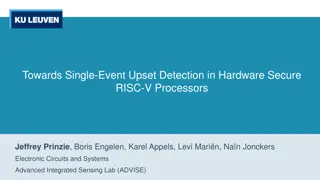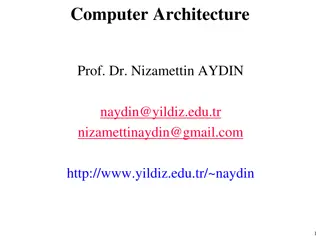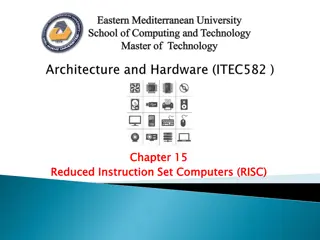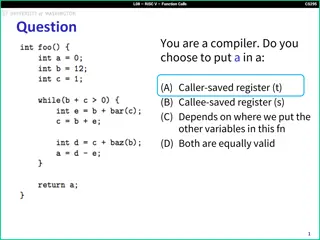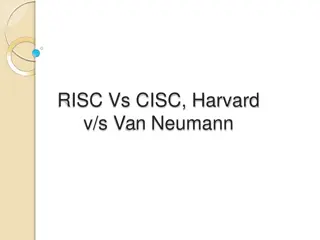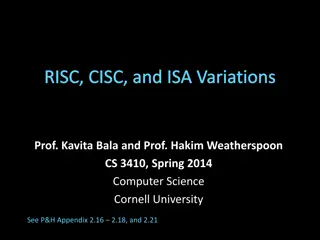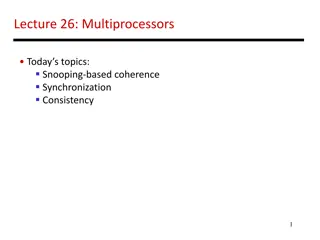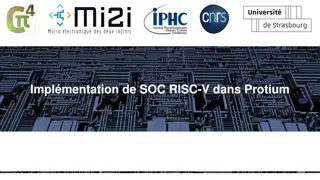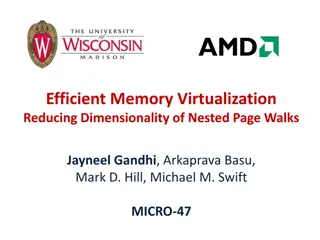Fast TLB Simulation for RISC-V Systems - Research Overview
TLB simulator for RISC-V systems introduced to evaluate TLB designs with realistic workloads, focusing on performance rather than cycle accuracy. The design sacrifices some accuracy for improved performance, making it suitable for meaningful software validation and profiling tasks.
Download Presentation

Please find below an Image/Link to download the presentation.
The content on the website is provided AS IS for your information and personal use only. It may not be sold, licensed, or shared on other websites without obtaining consent from the author.If you encounter any issues during the download, it is possible that the publisher has removed the file from their server.
You are allowed to download the files provided on this website for personal or commercial use, subject to the condition that they are used lawfully. All files are the property of their respective owners.
The content on the website is provided AS IS for your information and personal use only. It may not be sold, licensed, or shared on other websites without obtaining consent from the author.
E N D
Presentation Transcript
Fast TLB Simulation for RISC-V Systems Xuan Guo, Robert Mullins Department of Computer Science and Technology Both the paper and the slides are made available under CC BY 4.0
Motivation We want to evaluate TLB designs with meaningful workloads Not just microbenchmarks With the presence of an operating system Existing simulators are too slow for the task For TLB design, we don't need really cycle-accurate or cycle-approximate simulation
Design The inclusion requirement makes all TLB misses seen by the TLB simulator Not all TLB hits are seen by the TLB simulator Not possible to implement replacement policies like LRU Deliberate design choice to sacrifice some accuracy in exchange of performance Can still count number of TLB accesses by just counting number of memory ops This design keeps QEMU's fast path intact Except counters of memory/total ops
Application: Software Validation Utilise an ideal TLB implemented using hash map Can check incorrect use of ASID/page table ASID reused without flushing; Page table entries updated with different physical address or reduced permission, but there is no SFENCE.VMA. Multiple ASIDs used to refer to the same page table. We use the validator to validate our ASID implementation on Linux required for later experiments
Background: TLB Flushing in RISC-V Quote from the spec: The supervisor memory-management fence instruction SFENCE.VMA is used to synchronize updates to in-memory memory-management data structures with current execution. Instruction execution causes implicit reads and writes to these data structures; however, these implicit references are ordinarily not ordered with respect to loads and stores in the instruction stream. Executing an SFENCE.VMA instruction guarantees that any stores in the instruction stream prior to the SFENCE.VMA are ordered before all implicit references subsequent to the SFENCE.VMA. This is a fence instruction, not a conventional flush
How Linux handles the specification /* Commit new configuration to MMU hardware */ static inline void update_mmu_cache(struct vm_area_struct *vma, unsigned long address, pte_t *ptep) { /* * The kernel assumes that TLBs don't cache invalid entries, but * in RISC-V, SFENCE.VMA specifies an ordering constraint, not a * cache flush; it is necessary even after writing invalid entries. * Relying on flush_tlb_fix_spurious_fault would suffice, but * the extra traps reduce performance. So, eagerly SFENCE.VMA. */ local_flush_tlb_page(address); }
Implication of Linuxs Choice Never Accessed Previously Invalid Previously Non-Writable Necessary
Classification of Flushes Never Accessed Previously Invalid Previous Non-writable Necessary Cache: Cache: Cache: Cache: Eager: Eager: Eager: Eager: Linux: Linux: Linux: Linux: Sensible Hardware: Sensible Hardware: Sensible Hardware: Sensible Hardware:
Spec Suggestions Recommend against hardware from caching invalid entries Recommend software to assume that such case is unlikely But the software should still handle such case correctly Assuming a0 points to the PTE of a1, (a0) is originally invalid PTE and a2 is a valid PTE. sd a2, (a0) ld a3, (a1) If the load is issued and executed first, then the TLB may be accessed before the store is completed, so the SFENCE.VMA between sd and ld is necessary for this sequence despite hardware not caching invalid entries. Does not happen in proper OS though!
Background: ASID Space in RISC-V If OS/HW supports no ASIDs, ASID 0 is used everywhere. Implicitly suggest ASID 0 is not shared across harts. Different architectures have different design choices: ARM: Globally shared ASID space X86: Hart-local ASID space
Importance of Shared ASID Space Remote TLB shootdown Shared last-level TLB Inter-core cooperative prefetching
Experimental Setup Private Shared w/o Global ASID Shared w/ Global ASID Tag ASID VPN HartID ASID VPN ASID VPN L1 TLB Separate I-TLB & D-TLB, fully associative, 32 entries each 8-way associative, 128 entries per each core L2 TLB 8-way associative, 128*8 entries
Conclusion Allowing a shared ASID space has a clear advantage It will allow more possible hardware implementation It is vital for many-core designs and GPU-like systems Should definitely be allowed by the spec
MASI: Proposed Extension Single Extra CSR MASI (Machine Address Space Isolation) WARL Implementation can decide number of writable bits, from 0 to XLEN Non-writable bits are not necessary zero TLB entries are tagged with MASI MASI ASID VPN
Matching TLB Entries If MASI/VMID mismatches, entries are isolated If MASI/VMID matches: Global entries can match any ASID Non-zero ASIDs are shared across all harts Non-zero distinct ASIDs are isolated from each other ASID 0 of each hart is isolated from other harts' ASID 0 ASID 0 of harts may not be isolated from other non-zero ASIDs
Matching TLB Entries ASID 0 of harts may not be isolated from other non-zero ASIDs This constraint is cheap for software Makes initialisation slightly harder No extra overhead otherwise This constraint makes hardware handling of 0 much easier A hardware can simply map ASID 0 to some unique ASID number, e.g. their hart ID Now the only constraint is "Non-zero distinct ASIDs are isolated from each other"!
MASI: Examples Implementation that does not share TLBs MASI MASI MASI MASI Hardwired to 0 Hardwired to 1 Hardwired to 2 Hardwired to 3
MASI: Examples Implementation that does not support LPAR MASI MASI MASI MASI Hardwired to 0 Hardwired to 0 Hardwired to 0 Hardwired to 0
MASI: Examples Implementation that supports LPAR in addition to shared TLBs MASI 0bXX MASI 0bXX MASI 0bXX MASI 0bXX
MASI: Examples Multi-tile system where TLB is shared within a tile MASI MASI MASI MASI Hardwired to 0 Hardwired to 0 Hardwired to 1 Hardwired to 1
MASI: Examples Multi-tile system where TLB is shared within a tile, with LPAR within tile MASI 0b0X MASI 0b0X MASI 0b1X MASI 0b1X
MASI: Conclusion Flexible For most systems, it is just readonly Allows implementations to exploit ASID sharing at merely no cost Backward Compatible Existing supervisors either do not use ASID or assume shared ASID space anyway
Questions If you have questions or are generally interested in this topic, please contact author at Gary.Guo@cl.cam.ac.uk



